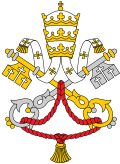| Part of a series on the |
| Roman Curia of the Holy See |
|---|
 |
| |
The Sacred Congregation of Rites was a congregation of the Roman Curia, erected on 22 January 1588 by Pope Sixtus V by Immensa Aeterni Dei ; it was divided into two separate congregations by Pope Paul VI on 8 May 1969.
Contents
The Congregation was charged with the supervision of the liturgy and the process of canonization of saints. [1]
As part of the reforms following the Second Vatican Council, Pope Paul VI's 1969 apostolic constitution Sacra Rituum Congregatio divided the congregation into: the Congregation for the Causes of Saints, and the Congregation for Divine Worship and the Discipline of the Sacraments. [1]